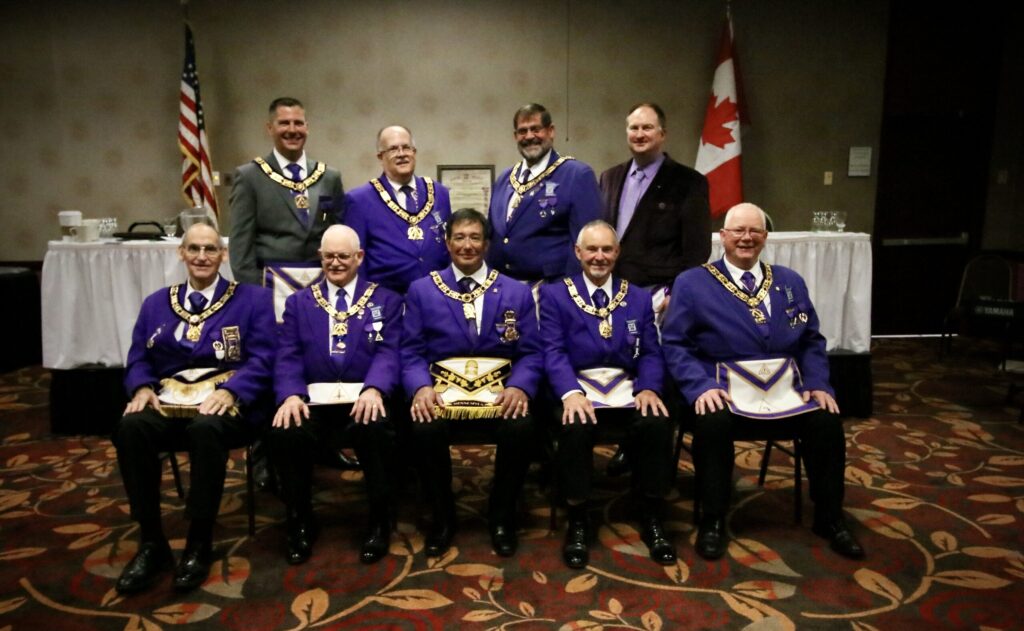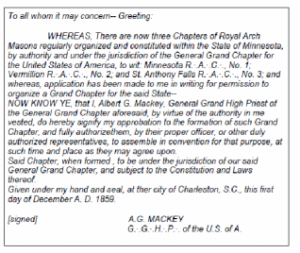Grand Council of Cryptic Masons

The Grand Council of Cryptic Masons of Minnesota
Origin of Our Grand Council

December 15, 1903
THE AMERICAN TYLER
The following is the substance of a paper read by William S. Combs, of St. Paul, at the banquet following the annual assembly of the grand council, R. and S. M., held in Minneapolis Oct. 12, 1903, with some added information furnished by the grand recorder:
Sometime during the year 1868 Compo A. T. C. Pierson, while on a visit to New York, secured a dispensation from the grand council of Royal and Select Masters of New York, or from the Grand Master thereof, to communicate the degrees of the Cryptic Rite upon such Royal Arch Masons in Minnesota as he might choose, with a view of forming a council. He selected for the honors the following companions of St. Paul, and possibly others: John C. Terry, Samuel Willey, Isaac P. Wright, Chas. W. Nash, Geo. W. Prescott, George L. Otis, Wm. S. Combs, Josiah Marvin and C. W. Carpenter. After he had communicated the degrees to the above named companions. a council was formed and officers chosen. Compo John C. Terry was installed as thrice illustrious master and Compo Wm. S. Combs, recorder. The council procured from Compo Geo. W. Seymour of Taylor’s
Falls a copy of the New York ritual, and in due time conferred the degrees upon a number of companions under authority of the aforesaid dispensation. When the time came to apply for a charter Companion Pierson refused to meet with or assist us, claiming that the Ancient and Accepted Scottish Rite for the southern jurisdiction, of which he was then an officer, had jurisdiction over the degrees of Royal and Select Master, and that consequently he was debarred from taking any further interest in our council. As a matter of fact, Companion Pierson, as such officer, communicated the degrees to several other Royal Arch Masons in St. Paul, who were subsequently healed and admitted into St. Paul council.
Being thus deprived of the assistance of Companion Pierson, I was urgently requested by the other companions of our council to apply to the grand council of Iowa for a charter. Accordingly, early in September, 1869, I sent a petition signed by nine companions to Ill. Compo T. S. Parvin of Iowa, and asked his aid and co-operation in procuring for us a charter from the grand council of Iowa.
Companion Parvin, on September 9th, presented our petition to Grand Recorder W. B. Langridge, which he immediately forwarded to Dubuque council, No. 3, for their recommendation. When the grand council met at Mt. Pleasant, October 21st, the petition had not been returned, but grand council being informed by Illustrious Companion Guilbert that the petition was duly recommended, it was voted that a charter be granted on the payment of the required fees. The new council was designated in the charter as St. Paul council, No. 11. The following from the address of Grand Master Benj. Crabb, delivered Oct. 15, 1870, to the grand council of Iowa, will be of interest in this connection:
“At the last meeting of the grand council, a petition was presented, signed by nine Royal and Select Masters of St. Paul, Minnesota, and properly recommended by Dubuque council, No.3, asking for a charter or dispensation to institute a council. The grand council granted their request, and instructed the grand recorder and myself to issue to said companions a charter. Previous to the issuing of said charter, A.T.C. Pierson, sovereign grand inspector general of Minnesota, protested in the most emphatic manner against said companions making application to this grand body for a charter, claiming that they should apply to him. Many questions were propounded to me upon this subject. I decided that this grand council had jurisdiction and that it was not only right and proper, but that it was our duty to Issue to said companions a charter. It was accordingly done, and on the 12th day of January, 1870, I issued a special commission to Compo J. C. Terry to constitute said council and install its officers. As to the proper jurisdiction in the above case, I learned it was brought before the southern supreme council of the A. & A. Scottish Rite, and that body refused to sustain the position assumed by said Pierson, and passed a resolution surrendering all claim they might have over the council degrees to grand councils, wherever organized.”
In the report on correspondence of the grand council of Iowa for 1870 Grand Recorder W. B. Langridge, who wrote same, says:
“As will be seen in the address of the M. P. grand master, the organization of councils by us in Minnesota caused a ripple of strife to break the otherwise placid surface of council matters. As the action growing therefrom is ‘Historical’ we append it:
“Some years previous to the organization of the St. Paul council, Illustrious Brother Azariah T. C. Pierson, thirty third degree, a member of the supreme council of the A. & A. Rite, for the southern jurisdiction, and the active inspector general for that rite in the state of Minnesota, had, as we understand, in the capacity of thrice illustrious master of a council formed under a dispensation issued by the grand master of the state of New York, made several Royal and Select Masters. This dispensation had not been followed by a charter, and the council accordingly disbanded. The illustrious companions thus formed, at length growing weary of inaction, took steps to effect an organization, and petitioning this grand council, a charter was issued to them at our session in 1869. Illustrious’ Brother Pierson claimed that all Royal and Select Masters made by him, should apply to him as an inspector general of the Scottish Rite for organization, seeming to overlook the distinction that it was not in the character of inspector general of the southern jurisdiction, but in that of thrice illustrious master of a council, subordinate to the grand council of the State of New York. that he had done this work. From this claim considerable correspondence arose, and some feeling was manifested. In the meantime two other councils were organized in Minnesota, one at Minneapolis and one at Rochester, which will apply at this session for charters. and, after obtaining them, we doubt not a grand council will at once be organized in Minnesota.
” Grand Master Crabb of Iowa, on May 5, 1870, issued a dispensation to Alfred E. Ames as T. I. M., Robert S. Alden as R. I. M., David M. Goodwin as P. C. W., and seven other companions, to organize a council in Minneapolis, and on July 18, 1870, to E. C. Cross as T. I. M., E. G. Covington as R. I. M., G. W. Van Dusen as P. e. “V., and six others, to open a council in Rochester, Minn. Charters were granted these new councils Oct. 15, 1870, as Minneapolis, No. 15, and Rochester, No. 16, and in doing so they were “permitted to retain their dispensations, as they wish to do so, as ‘ a matter of complete record in forming the grand council of Minnesota.” On Nov. 7, 1870, a dispensation was issued by Grand Master B. Crabb of Iowa to Ill. Companion Wm. S. Combs, of St. Paul council, No. 11, with power to constitute Minneapolis council, No. 15, and Rochester council, No. 16, and install their officers.
A more perfect union of the Minnesota members of the Cryptic Rite being desirable, a convention of delegates from the three existing councils was held in St. Paul in accordance with resolutions previously adopted by said councils. They met in the hall of St. Paul council on Dec. 12, 1870, to take such measures as were necessary to form a grand council. The convention was organized by the election of Compo Alfred E. Ames as president and Companion William S. Combs as secretary. The following companions presented their credentials and were duly received as delegates Minneapolis council, No. 15 -D. M. Goodwin, T. I. M.; John W. Henion, C.C.; A. E. Ames, past master. Rochester council, No. 16–E. C. Cross, T. I. M.; G. W. Van Dusen, P. C. W.
The president appointed Companion Wm. S. Combs, E. C Cross and D. M. Goodwin a committee to draft a constitution and regulations. These were unanimously adopted, a splendid presage of the harmony that has ever since continued in the grand council.
The first elective officers were John e. Terry, M. P. grand master; Alfred E. Ames, R. I. grand master; E.C. Cross, G. principal conductor of the work; M. W. Getchell, G. treasurer; Wm. S. Combs, G. recorder.
The M. P. grand master appointed the following officers:
Samuel \Villey, R. I. deputy grand master; Isaac P. Wright, G. chaplain: Geo. W. Van Dusen, G. captain of the guard; Henry L. Rockey, G. conductor of the council; John W. Henion. G. steward, and Chas. Shandrew , G. sentinel.
The grand council of Minnesota was then opened in ample form, and Ill. Companion A. E. Ames proceeded to install the officers-elect, Ill Companion D. M. Goodwin acting as grand marshal.
On motion of Ill. Compo A. E. Ames it was Resolved , That St. Paul council No. 11 Minneapolis council No. 15, and Rochester council, No. 16, whose charters were granted by the grand council of Iowa, now constituting the grand council of Minnesota, shall hereafter be designated in this jurisdiction as St. Paul council, No. 1, Minneapolis council, No.2, and Rochester council, No.3, of Royal and Select Masters, and the grand recorder is hereby directed to endorse on the back of the charters of said councils a copy of this resolution.
The first assembly of the grand council of Royal and Select Masters of Minnesota was then closed in ample form. This is the history of the Cryptic Rite in the early days. It has held its annual assemblies and has met with varying successes, but now it bids fair to have a prosperous future, and so may it ever continue.